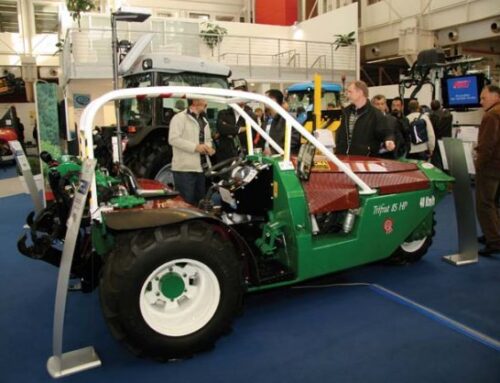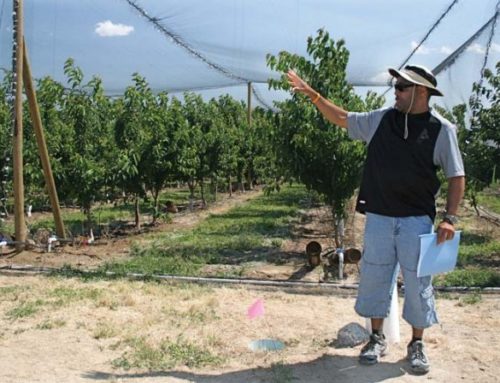Covering part of an existing vineyard makes for easy comparison of grapes grown inside and grapes grown outside. It’s very experimental.
Published January 15, 2011
Perhaps in the not too distant future, wine connoisseurs will pick up an expensive bottle of red wine and read on the label, “The Wine from Protected Grapes.” Intrigued, they’ll want to try it. And, delighted, they’ll want to buy more.
That’s the scenario Josh Rhem is working to help make happen. Among the 143 acres of wine grapes he provides management assistance for in the Traverse City, Michigan, area, four are under the plastic cover of high tunnels.
In the last 25 years, this idea of growing fruits and vegetables in unheated, plastic hoophouses has swept the world. But so far, these four acres are the world’s only wine grapes known to be grown in this manner.
“It’s a big experiment,” Rhem said. The grapes are owned by Croft LLC and managed by Rhem at Mutual Farm Management. Nearly an acre of grapes was covered by tunnels in the summer of 2005, and three more acres were covered last season. Some test batches of wine have been made, but the results are closely held.
So far, it’s all about growing the grapes in such a way that a winemaker will find them distinctive.
There are several ways in which these protected grapes are expected to be different, and, the investors hope, these differences will appear in measurable or discernable ways.
The plastic covers, which are put on early in the spring and taken off after fall harvest, will provide frost and freeze protection in both seasons, lengthening the time the grapes can grow. Rhem expects this will be most useful in the fall, giving the grapes a longer hang time.
The covers capture more heat during the summer—sometimes too much. Part of his job is monitoring the houses, pushing up sidewalls or opening ends, and venting the structures to avoid overheating. Overall, however, the tunnels will help collect more growing degrees
during the season, Rhem said.
Because the grapes are protected from rainfall and watered by trickle irrigation, a number of effects result. Since the amount of water can be managed, deficit irrigation techniques used in the West can be used to manipulate soluble solids levels in the grapes. And without wetness on the leaves and fruit, powdery mildew and bunch rots can be reduced—directly affecting wine quality and reducing the amount of fungicides needed for disease control.
“If we can keep the grapes dry, we are able to greatly reduce our pest control effort,” Rhem said.
The covers also protect ripening grapes from birds and insect pests and might provide an opportunity to make claims about reduced use of pesticides.
The tunnels are not expected to change some things—like vine susceptibility to winter injury. The tunnel plastic is rolled up each fall, and grapevines are fully exposed to the elements during the winter, so no effort will be made to grow less cold hardy varieties in the tunnels than can already be grown in the area.
Rhem monitors the tunnels, recording temperatures, relative humidity, and soil moisture both inside and outside to provide data to make comparisons. The tunnel environment is expected to affect the Brix, pH, and flavor elements as well as pest pressure.
English
The first high tunnels were put up in 2005 over three-quarters of an acre of a seven-acre field of Cabernet Franc and Merlot grapes that had been planted in 2001. The tunnels are just north of Traverse City at the base of the Old Mission Peninsula. Each 600-foot-long tunnel in the three-bay system covered two rows of grapes, and that wasn’t the best use of space.
The tunnels, made by Haygrove, an English company that has pioneered tunnels, are made of heavy conduit custom-bent on site and installed atop specially made steel posts that provide sidewalls 5.5 feet high. Each 20-foot-wide bay rises to 14 feet in the center.
In the later plantings, established near the end of the peninsula just feet from where the 45th parallel divides the Northern Hemisphere, the bays were 28 feet wide, and three rows of grapes fit inside, giving two 10-foot alleys and four feet of open space along each side. The wider bays give a somewhat taller clearance above the alleys.
Haygrove operations started in southern England in 1988 when the company put strawberries under plastic, increasing the six-week season to six months in that cloudy, humid country. Half the strawberries in the United Kingdom are now grown under Haygrove tunnels. Haygrove markets the tunnels internationally and has found highly profitable applications in raspberries and other soft fruit, sweet cherries, flowers, and other crops.
But this is the first and only for grapes. “We’re the only ones in the world doing it, so far,” Rhem said.
Rhem grew up on the Old Mission Peninsula, worked in vineyards as a youth and through college, and left for a decade to be a commercial fisherman. Now 36, he’s back in the vineyard in an area growing with boutique wineries and with established wine trails both on that peninsula and the next one west, the Leelanau Peninsula, which is also surrounded on three sides by Lake Michigan.
The glacial sand and gravel hills provide towering sites that draw wealthy summer homeowners, lots of tourists, and adventurous investors and winemakers.
Will The Wine from Protected Grapes fill a boutique niche? They’re working on it.



Leave A Comment